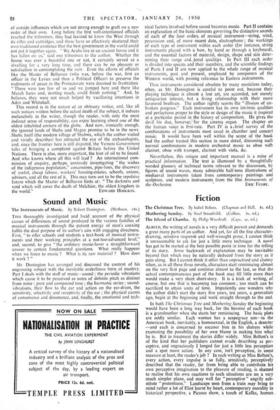Sound and Music
The Instruments of Music. By Robert Donington. (Methuen. 18s.) Tins thoroughly investigated and lucid account of the physical causes of differences of sound produced in the various families of musical instruments through the patient energy of man's coaxing fulfils the dual purpose of its author's aim with engaging directness. First, " to offer schools and students a text-book of musical instru- ments and their working principles at a not-too-advanced level," and, second, to give " the ordinary music-lover a straightforward answer to certain fundamental questions. What really happens when we listen to music ? What is its raw material ? How does it work ? "
Mr. Donington has arranged and discussed the content of his engrossing subject with the inevitable orderliness born of mastery. Part I deals with the stuff of music—sound ; the periodic vibrations which cause it to be perceived as notes of definite pitch AS distinct from noise ; pure and compound tone ; the harmonic series ; sound- vibrations, their flow to the ear and action on the ear-drum, the sensitivity, selectivity and receptivity of the ear ; the physical causes of consonance and dissonance, and, finally, the emotional and tech- nical factors involved before sound becomes music. Part II contains an explanation of the basic elements governing the distinctive sounds of each of the four orders of musical instrument—string, wind, percussion and, of more recent date, electrophone ; the workings of each type of instrument within each order (for instance, string instruments played with a bow, by hand or through a keyboard), and the essential factors of material, design, shape and size deter- mining their range and_tonal qualities. In Part III each order is divided into species and their members, and the scientific findings of Parts I and II are now applied to the whole range of musical instruments, past and present, employed by composers of the Western world, with passing reference to Eastern instruments.
Thus instruments considered obsolete by many musicians today, often, as Mr. Donington is careful to point out, because their playing technique is almost a lost art, are accorded, not merely antiquarian interest, but a living relationship with their more favoured brethren. The author rightly scorns the " illusion of un- broken progress." Each instrument has its own intrinsic qualities and perfections proper to the style or design of the music it inspired at a particular period in the history of composition. He gives the devil his due, howevar;; for the cinema organ. The chapter on the human voice is first-rate. Part IV is a brief survey of the combinations of instruments most usual in chamber and concert music. It would have been well within the scope of the book had the author treated this section in more detail, discussing such normal combinations in modern orchestral music as oboe with clarinet, oboe with trumpet, clarinet with viola, &c.
Nevertheless, this unique and important manual is a mine of practical information. The text is illumined by a thoughtfully worded glossary of technical terms relevant to the discussion, by figures of sound waves, many admirable half-tone illustrations of mediaeval instruments taken from contemporary paintings •and sculpture, and modern instruments from the film Instruments of


































 Previous page
Previous page